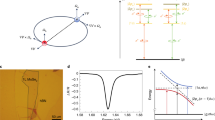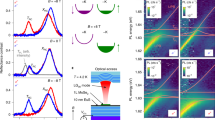Abstract
Floquet states, where a periodic optical field coherently drives electrons in solids1,2,3, can enable novel quantum states of matter4,5,6. A prominent approach to realize Floquet states is based on the optical Stark effect. Previous studies on the optical Stark effect often treated the excited state in solids as free quasi-particles3,7,8,9,10,11,12. However, exciton–exciton interactions can be sizeably enhanced in low-dimensional systems and may lead to light–matter interactions that are qualitatively different from those in the non-interacting picture. Here we use monolayer molybdenum diselenide (MoSe2) as a model system to demonstrate that the driving optical field can couple a hierarchy of excitonic states, and the many-body inter-valley biexciton state plays a dominant role in the optical Stark effect. Specifically, the exciton–biexciton coupling in monolayer MoSe2 breaks down the valley selection rules based on the non-interacting exciton picture. The photon-dressed excitonic states exhibit an energy redshift, splitting or blueshift as the driving photon frequency varies below the exciton transition. We determine a binding energy of 21 meV for the inter-valley biexciton and a transition dipole moment of 9.3 debye for the exciton–biexciton transition. Our study reveals the crucial role of many-body effects in coherent light–matter interaction in atomically thin two-dimensional materials.
This is a preview of subscription content, access via your institution
Access options
Access Nature and 54 other Nature Portfolio journals
Get Nature+, our best-value online-access subscription
$29.99 / 30 days
cancel any time
Subscribe to this journal
Receive 12 print issues and online access
$209.00 per year
only $17.42 per issue
Buy this article
- Purchase on Springer Link
- Instant access to full article PDF
Prices may be subject to local taxes which are calculated during checkout




Similar content being viewed by others
References
Shirley, J. H. Solution of the Schrödinger equation with a Hamiltonian periodic in time. Phys. Rev. 138, B979–B987 (1965).
Autler, S. H. & Townes, C. H. Stark effect in rapidly varying fields. Phys. Rev. 100, 703–722 (1955).
Galitskii, V. M., Goreslavskii, S. P. & Elesin, V. F. Electric and magnetic properties of a semiconductor in the field of a strong electromagnetic wave. J. Exp. Theor. Phys. 30, 117–122 (1970).
Gupta, J. A., Knobel, R., Samarth, N. & Awschalom, D. D. Ultrafast manipulation of electron spin coherence. Science 292, 2458–2461 (2001).
Lindner, N. H., Refael, G. & Galitski, V. Floquet topological insulator in semiconductor quantum wells. Nat. Phys. 7, 490–495 (2011).
Berezovsky, J., Mikkelsen, M. H., Stoltz, N. G., Coldren, L. A. & Awschalom, D. D. Picosecond coherent optical manipulation of a single electron spin in a quantum dot. Science 320, 349–352 (2008).
Sie, E. J. et al. Valley-selective optical Stark effect in monolayer WS2. Nat. Mater. 14, 290–294 (2015).
Kim, J. et al. Ultrafast generation of pseudo-magnetic field for valley excitons in WSe2 monolayers. Science 346, 1205–1208 (2014).
Von Lehmen, A., Chemla, D. S., Heritage, J. P. & Zucker, J. E. Optical Stark effect on excitons in GaAs quantum wells. Opt. Lett. 11, 609–611 (1986).
Cohen-Tannoudji, C. & Reynaud, S. Dressed-atom description of resonance fluorescence and absorption spectra of a multi-level atom in an intense laser beam. J. Phys. B 10, 345–363 (1977).
De Giovannini, U., Hübener, H. & Rubio, A. Monitoring electron–photon dressing in WSe2. Nano Lett. 16, 7993–7998 (2016).
Sie, E. J. et al. Large, valley-exclusive Bloch–Siegert shift in monolayer WS2. Science 355, 1066–1069 (2017).
Cao, T. et al. Valley-selective circular dichroism of monolayer molybdenum disulphide. Nat. Commun. 3, 887–891 (2012).
Xiao, D., Liu, G.-B., Feng, W., Xu, X. & Yao, W. Coupled spin and valley physics in monolayers of MoS2 and other Group-VI dichalcogenides. Phys. Rev. Lett. 108, 196802 (2012).
Xu, X., Yao, W., Xiao, D. & Heinz, T. F. Spin and pseudospins in layered transition metal dichalcogenides. Nat. Phys. 10, 343–350 (2014).
Splendiani, A. et al. Emerging photoluminescence in monolayer MoS2. Nano Lett. 10, 1271–1275 (2010).
Ugeda, M. M. et al. Giant bandgap renormalization and excitonic effects in a monolayer transition metal dichalcogenide semiconductor. Nat. Mater. 13, 1091–1095 (2014).
Zhang, D. K., Kidd, D. W. & Varga, K. Excited biexcitons in transition metal dichalcogenides. Nano Lett. 15, 7002–7005 (2015).
Kylänpää, I. & Komsa, H.-P. Binding energies of exciton complexes in transition metal dichalcogenide monolayers and effect of dielectric environment. Phys. Rev. B 92, 205418 (2015).
Mak, K. F., He, K., Shan, J. & Heinz, T. F. Control of valley polarization in monolayer MoS2 by optical helicity. Nat. Nanotechnol. 7, 494–498 (2012).
Chernikov, A. et al. Electrical tuning of exciton binding energies in monolayer WS2. Phys. Rev. Lett. 115, 126802 (2015).
Ye, Z., Sun, D. & Heinz, T. F. Optical manipulation of valley pseudospin. Nat. Phys. 13, 26–29 (2017).
Mak, K. F., McGill, K. L., Park, J. & McEuen, P. L. The valley Hall effect in MoS2 transistors. Science 344, 1489–1492 (2014).
Rivera, P. et al. Valley-polarized exciton dynamics in a 2D semiconductor heterostructure. Science 351, 688–691 (2016).
Claassen, M., Jia, C., Moritz, B. & Devereaux, T. All-optical materials design of chiral edge modes in transition-metal dichalcogenides. Nat. Commun. 7, 13074 (2016).
Mak, K. F. et al. Tightly bound trions in monolayer MoS2. Nat. Mater. 12, 207–211 (2013).
You, Y. et al. Observation of biexcitons in monolayer WSe2. Nat. Phys. 11, 477–481 (2015).
Hao, K. et al. Neutral and charged inter-valley biexcitons in monolayer MoSe2. Nat. Commun. 8, 15552 (2017).
Sie, E. J., Lui, C. H., Lee, Y.-H., Kong, J. & Gedik, N. Observation of intervalley biexcitonic optical Stark effect in monolayer WS2. Nano Lett. 16, 7421–7426 (2016).
Moody, G. et al. Intrinsic homogeneous linewidth and broadening mechanisms of excitons in monolayer transition metal dichalcogenides. Nat. Commun. 6, 8315 (2017).
Jin, C. et al. Interlayer electron–phonon coupling in WSe2/hBN heterostructures. Nat. Phys. 13, 127–131 (2017).
Acknowledgements
This work was primarily supported by the US Department of Energy, Office of Science, Office of Basic Energy Sciences, Materials Sciences and Engineering Division under contract no. DE-AC02-05-CH11231 (Van der Waals Heterostructures program KCWF16). Preparation of the hBN-encapsulated monolayer MoSe2 is supported by the National Science Foundation EFRI programme (EFMA-1542741). Growth of hBN crystals was supported by the Elemental Strategy Initiative conducted by the MEXT, Japan and JSPS KAKENHI grant numbers JP15K21722 and JP25106006. S.T. acknowledges the support from NSF DMR 1552220 NSF CAREER award.
Author information
Authors and Affiliations
Contributions
C.-K.Y. and F.W. conceived the research. C.-K.Y. carried out optical measurements, assisted by J.H. and C.-S.Y. C.-K.Y., F.W. and J.H. analysed the data and performed theoretical analysis. J.H. fabricated the devices, assisted by A.W., C.-K.L. and S.Z. Y.S, H.C. and S.T. synthesized MoSe2 crystals. K.W. and T.T. synthesized hBN crystals. C.-K.Y. and F.W. wrote the manuscript, with input from all authors.
Corresponding authors
Ethics declarations
Competing interests
The authors declare no competing interests.
Additional information
Publisher’s note: Springer Nature remains neutral with regard to jurisdictional claims in published maps and institutional affiliations.
Supplementary information
Supplementary Information
Supplementary Figures S1–S4
Rights and permissions
About this article
Cite this article
Yong, CK., Horng, J., Shen, Y. et al. Biexcitonic optical Stark effects in monolayer molybdenum diselenide. Nature Phys 14, 1092–1096 (2018). https://doi.org/10.1038/s41567-018-0216-7
Received:
Accepted:
Published:
Issue Date:
DOI: https://doi.org/10.1038/s41567-018-0216-7
This article is cited by
-
Floquet engineering of strongly driven excitons in monolayer tungsten disulfide
Nature Physics (2023)
-
Symmetry-dependent exciton-exciton interaction and intervalley biexciton in monolayer transition metal dichalcogenides
npj 2D Materials and Applications (2022)
-
Excitonic Bloch–Siegert shift in CsPbI3 perovskite quantum dots
Nature Communications (2022)
-
Strong spin-orbit coupling inducing Autler-Townes effect in lead halide perovskite nanocrystals
Nature Communications (2021)
-
Localization-limited exciton oscillator strength in colloidal CdSe nanoplatelets revealed by the optically induced stark effect
Light: Science & Applications (2021)



